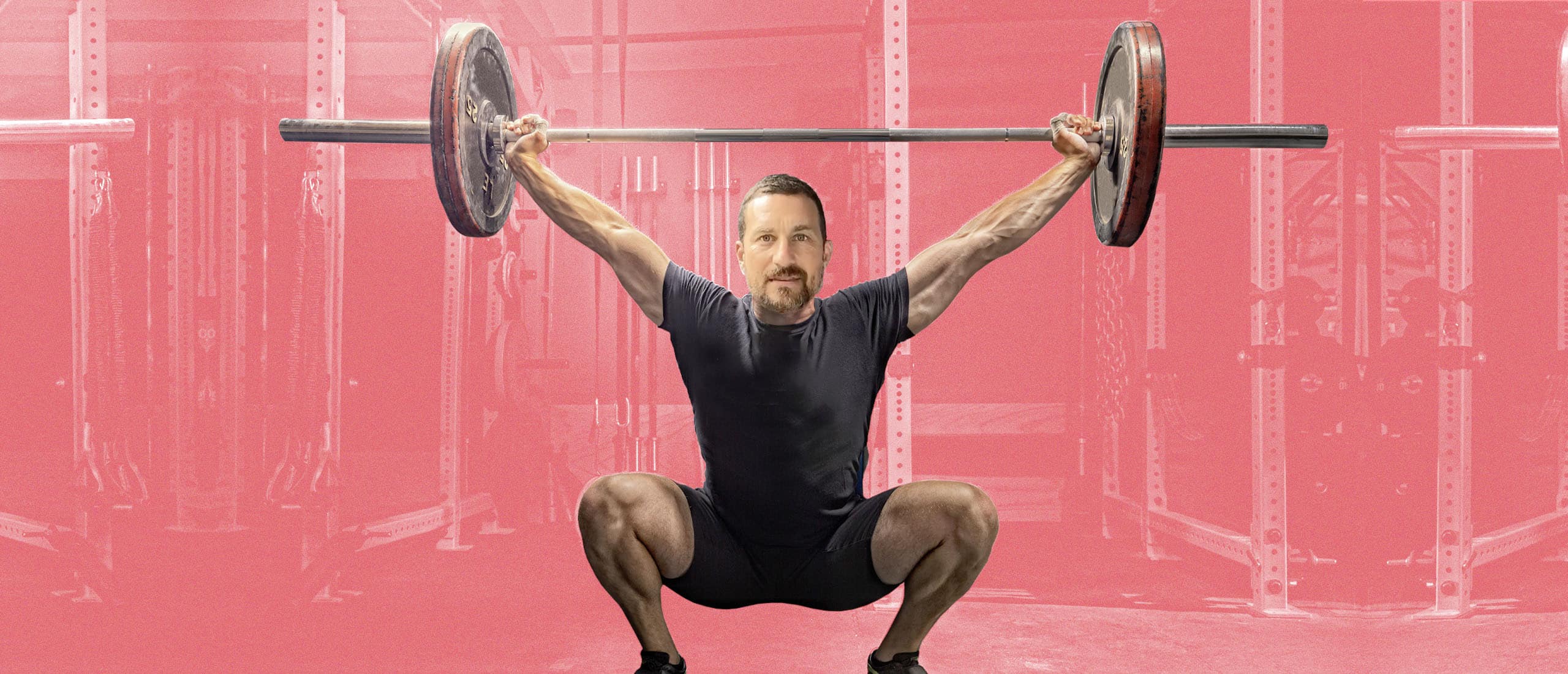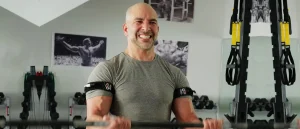Want to Optimize Health Without Losing Gains? Try Andrew Huberman’s Workout Routine
Neuroscientist and Huberman Lab host, Andrew Huberman, Ph.D. is jacked. There, we said it. While longevity experts have historically sat atop their high horses spewing health advice all the while appearing to age faster than ever, one look at Huberman’s physique can confirm he actually heeds his advice. A recent YouTube video posted by Cameron Hanes confirms the guy is built like a brick shithouse. Which has led droves of followers to Reddit with one question: What in the heck is Huberman doing at the gym?
Lucky for you, Huberman has spilled his entire fitness routine—which he calls his “foundational fitness protocol”—in extreme detail. Here’s the scoop.
What Is Andrew Huberman’s Foundational Fitness Protocol?
Huberman has followed his “foundational fitness protocol” for over 20 years. “In my mind, a foundational fitness protocol leaves you in a state where if you need to walk really far and carry a bunch of weight, you can do it. If you need to lift a heavy object with your legs, you can do it. If you need to run really fast for two minutes, you can do it. And if you need to run a little further like maybe 10 minutes, you can do that,” says Huberman. His fitness protocol aims to hit all the bases.

Each day of his program focuses on one key aspect of physical fitness which he claims is critical for health, longevity, and “aesthetic balance.” The routine is designed to target all major fitness goals, including strength, hypertrophy (or muscle growth), and endurance while hitting your immediate and long-term health needs.
Huberman is also quick to point out that the protocol is more of a rough guide than a strict program. He recommends modifying the schedule (i.e. swapping days four and five, or combining days if you miss a day, etc.) as needed. Each week breaks down to:
- Three days of resistance training
- Three days of cardiovascular training
- One day of deliberate heat and cold exposure
Resistance Training
When it comes to the weight room, Huberman doesn’t mess around. “Keep weight workouts to 50 to 60 minutes of hard work after a warm up, 75 minutes maximum. Warm up, then get it done,” Huberman wrote on his blog.
When Huberman is working out, that’s his sole focus. “I work really hard, not necessarily until failure, but hard work where I’m struggling to complete the final repetitions, if not going to failure,” Huberman said on Huberman Lab. Plus, he told Chris Williamson on the Modern Wisdom Podcast that he keeps his phone off for most workouts to minimize distractions.
He alternates between strength and hypertrophy
Many strength routines either focus on building strength or hypertrophy. Most don’t do both, at least not well. That’s because while training for either can simultaneously boost both strength and hypertrophy, there’s a specific protocol that will better cater to strength and another that’s more ideal for hypertrophy.
Huberman has a fix for that. He alternates his training schedule on a monthly basis (which he calls schedules A and B) to optimize for both. One month hitting strength and the next focusing on hypertrophy:
|
Focus |
Load |
Reps (per exercise) |
Sets (per exercise) |
Rest (per exercise) |
|
|
Schedule A |
Strength |
Heavy |
4-8 |
3-4 |
2-4 minutes |
|
Schedule B |
Hypertrophy |
Moderate |
8-15 |
2-3 |
90 seconds |
He trains his muscles in both a lengthened and shortened position
Bodybuilders are obsessed with training their muscles in a lengthened position (or when the muscle is under tension while stretched). Why? Studies have shown training a muscle in a lengthened position can be more effective for building strength and hypertrophy (1, 2, 3).
Huberman, on the other hand, prefers to hit muscles from both a shortened and lengthened position since hitting both end ranges of motion (where injuries are most likely to occur) can increase stability and control, improve movement quality, and reduce your risk of injury. He selects two exercises per muscle group each workout, each targeting the muscle through a different range of motion. For example:
|
Maximal Muscle Contraction |
Muscle Action |
Examples |
|
|
Exercise 1 |
Shortened |
Muscle is shortened at the end of the range of motion |
Seated calf raises, leg curls, leg extensions, chest cable crossovers, preacher curls |
|
Exercise 2 |
Lengthened |
Muscle is lengthened at the end of the range of motion |
Standing calf raises, glute-ham raises or straight-legged deadlifts, deep squats, incline presses, incline dumbbell curls |
His split involves three highly specific training days
Huberman claims his ability to recover is relatively poor, which is why he spaces out his workouts much further than you’d see on your typical bro split or PPL split—both of which Huberman isn’t a fan of. “Why would you name something after a bro? Now anyone who doesn’t categorize themselves as a bro isn’t interested,” he said on an episode of Huberman Lab. Fair.
He focuses on three direct strength training workouts a week, and a few indirect ones. For example, on Monday he directly trains his legs during a structured leg day workout, then on Friday he indirectly trains his legs again during an all-out HIIT run. This schedule allows him to hit his cardio and strength goals without one of them taking a performance hit. And to the haters, he claims this combination of direct and indirect training has been enough to make consistent strength and cardiovascular gains.
Here’s an example of how he breaks down his three “direct” strength workouts each week:
|
Daily Focus |
Description |
Exercise Examples |
|
Day two: Legs |
|
|
|
Day four: Torso and Neck |
|
|
|
Day seven: Arms, Neck, and Calves |
|
|
He doesn’t skimp on neck or knees-over-toes training
You’ll see some out-of-the-box additions to Huberman’s routine like tibialis raises and neck training. These exercises are intentional. According to Huberman, neck training is commonly overlooked but can reduce your risk of injury and improve posture. On an episode of The Tim Ferris Show, Huberman told Tim Ferris he does a few simple plate exercises to strengthen his neck:
- Lateral Head Raises: Lie on your side and rest a light plate on the side of your head. Lift your head pushing up against the weight.
- Head Raises: Lie on your stomach and rest a light plate on the back of your head. Lift your head (aka the opposite of tech neck) pushing up against the weight.
When it comes to tibialis raises, Huberman credits Ben Patrick, famously known as “Knees Over Toes Guy.” Per Patrick, it’s a misconception that your knees need to stay behind your toes during a squat. When programmed progressively, training with your knees over toes can strengthen your knees and improve performance.
Patrick recommends starting with backward walking and tibialis raises—both of which make an appearance in Huberman’s regular routine. He likes to throw on a weighted vest for a backward hill walk. And rather than a simple set of bodyweight tib raises against a wall, Huberman starts his leg day with three sets of six to ten heavy reps to failure—a practice he claims helped him grow bigger, stronger calves and improved his posture.
He uses breathing to aid recovery
During resistance training, Huberman recommends lowering your heart rate between sets by using a physiological sigh.
Take two sharp inhales of breath, ideally through the nose, followed by an extended exhale through the mouth. The second inhale in the double inhale is “really important,” Huberman says, allowing for not just the intake of more oxygen, “but also the offload of carbon dioxide.”
After just one or two physiological sighs, you may feel more relaxed, but Huberman recommends a full three to five minutes to “downshift” the nervous system, relax the mind and body, and aid muscle recovery.
Cardiovascular Training
Huberman depends on a mix of high-intensity interval training (HIIT), zone 2 training, and moderate-intensity cardio to build his cardiovascular fitness and endurance. While his week is built around three specific cardio workouts, he leaves the method (i.e. rucking, running, cycling, rowing) flexible so he can change it based on his mood.
Here’s how he breaks down his average week:
|
Daily Focus |
Description |
Exercise Examples |
|
Day one: Long Endurance Workout |
|
|
|
Day five: Cardiovascular Training |
|
|
|
Day six: High-Intensity Interval Training |
|
|
He prioritizes zone 2 cardio
Huberman almost always starts his week with zone 2 cardio. If you aren’t familiar, zone 2 is cardio performed at a relatively low intensity for an extended period of time. It’s basically steady-state endurance cardio—think going for a long jog or a hike—but with a specific purpose.
That purpose is to get your heart rate right in the Goldilocks zone. “You’re pushing yourself to move such that you’re breathing faster than normal, your heart is beating faster than normal; however, you’re still able to sustain a conversation. But, if you were to push yourself any harder—that is, move faster or go up a steeper incline you happen to be at any one moment—you would lose that ability to speak, you wouldn’t be able to complete full sentences, you would be out of breath, and you would have to pause mid-sentence,” Huberman explains.
Huberman prefers to jog, ruck, or hike, but that doesn’t mean you have to. Cycling, swimming, rowing, walking, or the elliptical also qualify—so long as it’s an activity you can maintain for well over 30 minutes, with the goal of working up to 60 to 75 minutes.
During his zone 2 workouts, Huberman strives to do purely nasal breathing—or breathing out of his nose exclusively, rather than his mouth. Why? Researchers believe nasal breathing is more efficient than mouth breathing and can help calm the body which allows you to function better during your workouts (4).
He works out at higher intensities to build his VO2 max
After age 30, your heart’s peak capacity (VO2 max) drops by about 10 percent per decade—and by as much as 15 percent after the age of fifty (5). Your VO2 max is key for maintaining both your physical fitness and functional ability to do everyday tasks, like climbing the stairs or carrying a basket of laundry down the hall. The only way to increase and maintain your VO2 max is to train at a high level—which is where Huberman’s moderate- and high-intensity cardio workouts come in.
The moderate workout is simple. Just head outside, and work a bit harder than you would for zone 2. This time, you shouldn’t be able to talk more than a word or two at a time. Your target is 75 to 80 percent of your all-out effort. If you’re using a heart rate monitor, Huberman recommends using the simple equation 220 minus your age to get your max heart rate. You can calculate your zones from there.
As for high-intensity cardio, Huberman prefers to use an assault bike or rowing machine, but he’ll head outside for some old-fashioned sprints in a pinch. “I don’t use a heart rate monitor, what I’m trying to do is get to that point where I quote-on-quote feel like I want to die. No, I don’t want to die. Please don’t die, right? But I want to get to the point where I could not pedal or pull any faster,” says Huberman.
Sprints are the status quo, but Huberman suggests picking an activity you feel comfortable with.
“I don’t recommend going all out on any movement that you can’t perform with perfect form,” he says. If you’re mid-HIIT and your form starts to waver, pull back on effort. Knowing his running form isn’t the best, Huberman typically holds back on sprints from the jump (opting for around 95 effort instead of 100) to avoid injury.
He takes his cardio outside once a week
In a recent Instagram post, Huberman explains one of the most important parts of his fitness protocol is to get outside and move as much as possible in nature. “Sometimes that’s a run, sometimes it’s a hike, sometimes that’s a ruck. Sometimes I do that alone, sometimes I do that with people. The point is to get outside into nature and move, weather permitting,” he explains in the post.
Studies have linked spending time outdoors with less stress and better cognitive function (6, 7). Huberman notes the easiest workouts to do outside will be either your zone 2 or moderate-intensity cardio where you’ll be able to take in the nature around you, rather than sprints where you’ll likely be spending all your effort on surviving the task at hand.
Cold and Heat Exposure
Like the rest of his routine, Huberman’s recovery routine is highly specific. According to him, there’s a right way—and wrong—way to embrace heat and cold exposure. Here’s how he gets his:
- Sauna: 20 minutes (176 to 212 degrees Fahrenheit)
- Ice Bath or Cold Shower: 5 minutes (aim for a temperature that feels really cold to you, but something you can safely stay in)
Rinse and repeat three to five times. Yes, three to five. All in all, you can expect the protocol to take 75 minutes to two hours and some change. Start slow, and per Huberman, increase the time (and temperature) only as tolerated.
Huberman’s heat and cold exposure day typically lands on day three of his routine, in between his leg day and upper body day—that’s intentional. The anti-inflammatory effects of cold exposure can limit hypertrophy, reducing the effectiveness of your resistance training workouts if you hop in an ice bath too soon (8). Avoid lumping an ice bath on the same day as resistance training. If you have to, Huberman recommends waiting at least six to eight hours before taking the plunge.
References
1. Pallares, J. et al (2021). Effects of Range of Motion on Resistance Training Adapations: A Systematic Review and Meta-Analysis.
2. Schoenfeld, B. et al (2020). Effects of Range of Motion on Muscle Development During Resistance Training Interventions: A Systematic Review.
3. Pedrosa, G. et al (2022). Partial Range of Motion Training Elicits Favorable Improvements in Muscular Adaptations When Carried Out at Long Muscle Lengths.
4. Dallam, G, et al (2018). Effect of Nasal Versus Oral Breathing on VO2 Max and Physiological Economy in Recreational Runners Following an Extended Period Spent Using Nasally Restricted Breathing.
5. Kim, C. et al (2016). The Effect of Aging on Relationship Between Lean Body mass and VO2 Max in Rowers.
6. Kondo, M. et al (2018). Does Spending Time Outdoors Reduce Stress? A Review of Real-Time Stress Response to Outdoor Environments.
7. Jiminez, M. et al (2021). Associations Between Nature Exposure and Health: A Review of the Evidence.
8. Peake, J. et al (2020). The Effects of Cold Water Immersion and Active Recovery on Molecular Factors That Regulate Growth and Remodeling of Skeletal Muscle After Resistance Exercise.













